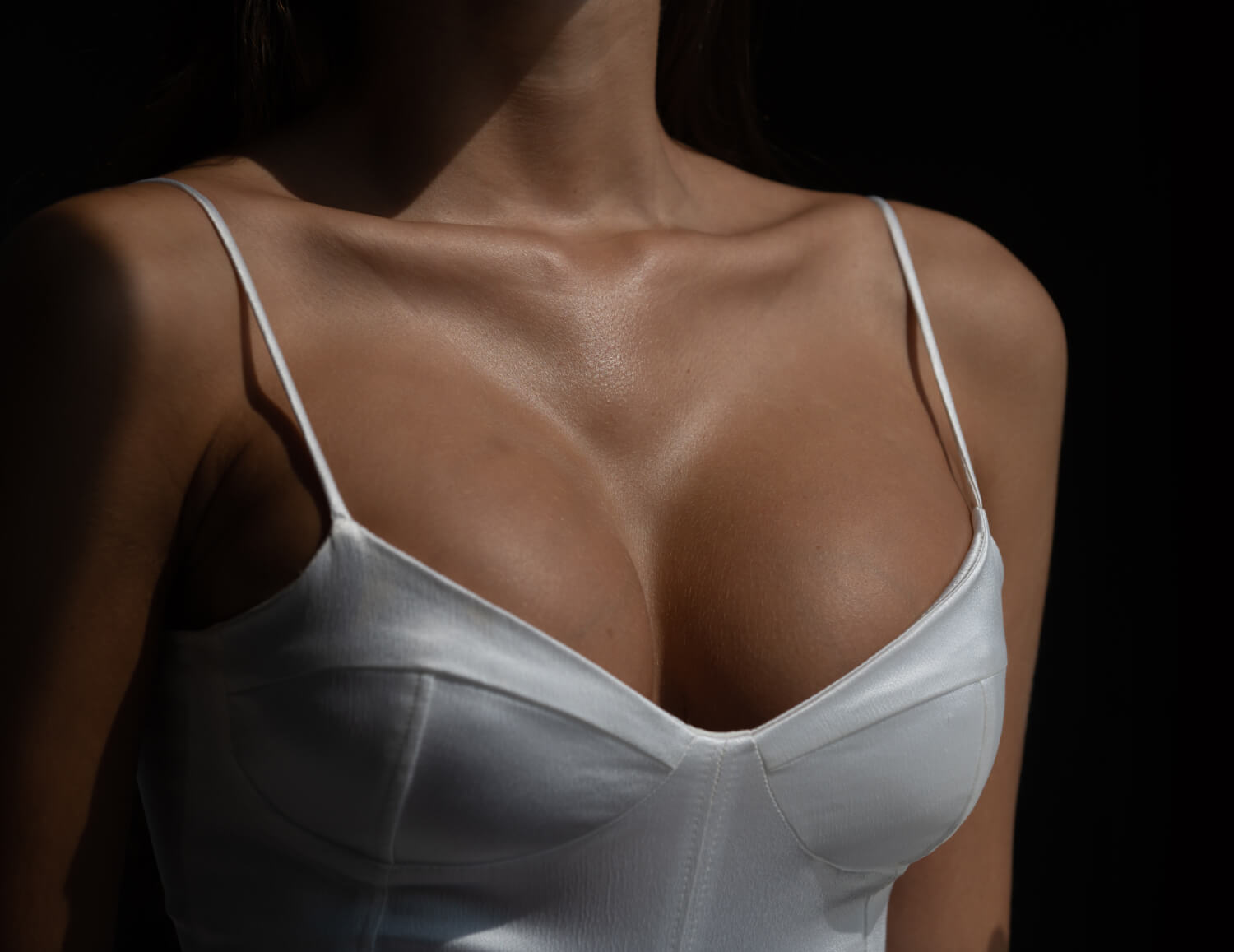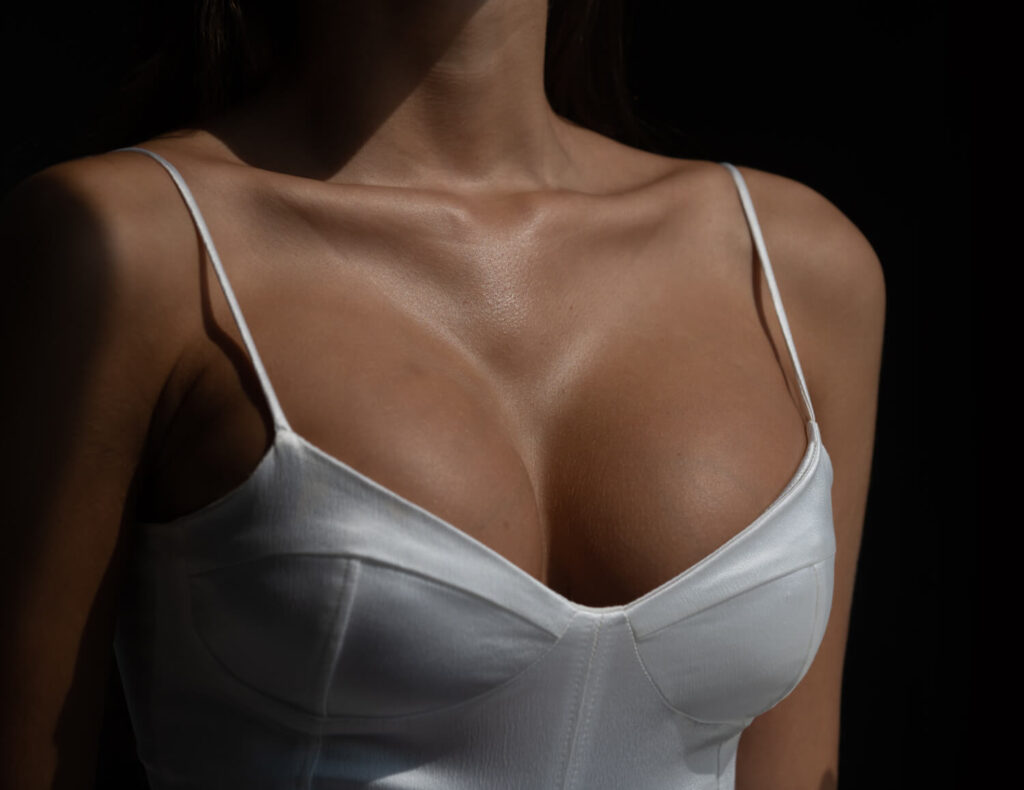Overview Breast Surgery
Breast surgery includes aesthetic and reconstructive procedures to enlarge, reduce, or restore breast shape.
Specialists in Breast Surgery
Welcome to InGold Aesthetics – your specialist for modern and excellent breast surgery in Switzerland. Our renowned FMH board-certified surgeon, Dr. Sylvana Ingold, with international training in the field of aesthetic and plastic surgery, and her team of experts offer first-class aesthetic and plastic surgery. With her extensive experience and specialization in breast surgery, she will help you achieve a new body image and increased self-confidence.
Centrally located in the beautiful cities of Zug and Bern, our clinics at InGold Aesthetics offer easy access and state-of-the-art facilities. We are proud to offer a state-of-the-art, accredited operating room and an exclusive VIP private recovery room where you can recover in comfort after surgery. These first-class facilities ensure that you receive the highest quality of care and comfort throughout your treatment and recovery.
Trust your skin and your beauty only to the experts.
We enhance your beauty with harmonious and long-lasting results.
Our internationally renowned specialists offer first-class care and security.
We use the latest technologies to deliver precise results that meet the highest standards.
Our team combines surgery, medicine, anti-aging, and dentistry to comprehensively meet your aesthetic needs.
As a leading educational institution, we train doctors and set international standards.
Breast Surgery

Breast Enlargement
Discover the possibilities of breast augmentation at our aesthetic surgery clinic. Using state-of-the-art techniques and individually tailored implant shapes of the highest quality, we can help you achieve the volume and perfect shape you desire. Our experienced team is on hand to answer your questions and guide you on your journey to your dream body. Learn more about the different methods and the results we can achieve for you.

Breast Reduction
Are you suffering from the discomfort of overly large breasts? Our clinic offers customized breast reductions that offer both aesthetic and health benefits. The procedure can relieve back and neck pain and achieve a more harmonious body image. Our experienced surgeons are available to help you find the best approach for your individual needs.

Breast Lift
A breast lift can help you achieve a firmer and more youthful appearance. Our specialized surgeons offer state-of-the-art procedures to lift and shape your breasts, helping you feel comfortable and confident in your body again. Learn how a breast lift can improve your appearance and enhance your silhouette. Let us advise you on a personalized consultation and discover the options available to you.

Breast Surgery Revision
Are you experiencing problems with a previous breast surgery? Our breast revision experts can help you correct complications and achieve your desired results. Whether it’s replacing implants, correcting asymmetries, or treating capsular contracture, we offer customized solutions to meet your needs. Learn how we can help you meet your expectations and achieve optimal results.

Nipple Surgery / Areola Surgery
Are you dissatisfied with the shape or size of your nipples or areolas? Our specialized surgeons offer precise and gentle nipple and areola correction procedures. Whether reduction, alignment, or shape correction – we help you achieve a harmonious and aesthetic appearance. Learn more about the options and techniques of nipple and areola surgery.

Breast Capsulectomy / Capsulotomy
A breast capsulectomy or capsulotomy may be necessary if a painful or hardened capsule forms around an implant. Our experienced surgeons offer effective solutions to correct this problem and improve your quality of life. Learn how these procedures are performed and what results you can expect.

Gynecomastia
Gynecomastia, the enlargement of the male breast, can be very stressful for those affected. Our clinic offers specialized procedures for male breast reduction and the restoration of a masculine breast profile. Learn more about the causes, treatment options, and the procedure for gynecomastia surgery. Consult our experts and regain your self-confidence.
Methoden zur Korrektur der Gynäkomastie
LIPOSUKTION/FETTABSAUGUNG
Bei der Liposuktion wird überschüssiges Fettgewebe aus der Brust entfernt. Diese Methode ist besonders effektiv, wenn die Gynäkomastie hauptsächlich durch Fettansammlungen verursacht wird.
EXZISION
Bei der Exzision wird überschüssiges Drüsengewebe chirurgisch entfernt. Diese Methode wird oft in Kombination mit der Liposuktion angewendet.
LIPOLYSE MIT LASER ODER BODYTITE
Sowohl Lipolyse mit Laser als auch die BodyTite-Technologie sind minimalinvasive Verfahren, die Fettzellen gezielt zerstören und die Haut straffen.
ULTRASCHALL ASSISTIERTE LIPOSUKTION (UAL)
Diese Methode verwendet Ultraschallenergie, um Fettzellen zu verflüssigen, bevor sie abgesaugt werden.
Questions & Answers
Am I suitable for a breast lift?
If you suffer from sagging breasts following pregnancy, weight loss, or the natural aging process, you may be a suitable candidate. A personalized consultation with us will help assess this.
Does health insurance cover the costs of a breast lift?
In most cases, health insurance won’t cover the costs because a breast lift is considered a cosmetic procedure. Exceptions may apply if medical conditions are present.
How does a breast lift differ from other breast surgeries?
Unlike breast augmentation or reduction, which changes volume, a breast lift lifts and shapes the tissue without significantly changing size.
How severe is the scarring after a breast lift?
Scarring depends on the technique used. Modern techniques aim to keep scars as minimal as possible, and the scars fade over time.
Am I suitable for breast reduction?
Suitability depends on your overall health, body weight, and expectations for the results. A personal consultation with us will help you make the best decision.
Does health insurance cover the costs of a breast reduction?
In some cases, especially if there are health problems such as back pain or skin problems, the costs can be covered by the health insurance company.
How severe is the scarring after a breast reduction?
Scarring depends on the technique used. Modern procedures aim to keep scars as minimal as possible, and most scars fade over time.
What is gynecomastia and how does it arise?
Gynecomastia refers to the enlargement of the male breast glands, often caused by hormonal imbalances, weight gain, genetic predisposition or certain medications.
Am I suitable for breast reduction surgery for gynecomastia?
Yes, if you suffer from breast enlargement and it is causing aesthetic or health problems. An assessment at our clinic will determine whether the treatment is suitable for you.
How does breast reduction differ for men and women?
Male breast reduction focuses on the removal of fat and glandular tissue to create a flatter, masculine breast shape, while in women the focus is often on volume and skin management.
Are there visible scars after breast reduction in men?
The scars are usually small and unobtrusive, as the incisions are often placed around the nipple area or in natural skin folds. With proper aftercare, they fade over time.
Does health insurance cover the costs of gynecomastia surgery?
In certain cases, if breast augmentation causes significant health problems, health insurance may cover the costs. A medical assessment is required.
What are the advantages of gynecomastia excision compared to liposuction alone?
While liposuction removes excess fat, excision is the only method to completely remove enlarged glandular tissue. This results in a flatter and permanently stable result.
Can gynecomastia excision be combined with other procedures?
Yes, many patients choose a combination of excision and liposuction or other aesthetic procedures to achieve the best overall result and to shape the upper body harmoniously.
What aftercare is necessary after a gynecomastia excision? WARNING
Is gynecomastia excision covered by health insurance?
In most cases, gynecomastia excision is considered a cosmetic procedure and therefore not covered by health insurance. However, if there are medical reasons, coverage may be possible in individual cases. Consulting your insurance provider is recommended.
How does breast augmentation with implants differ from breast augmentation with fat transfer?
Implants offer more control over volume and shape, while fat grafting provides subtle, more natural results.
Will the costs be covered by health insurance?
As a rule, breast enlargement for aesthetic reasons is not covered by health insurance unless there are medical indications such as breast reconstruction.
How long is the recovery time after breast augmentation?
Most patients can resume light activities after one week, while full recovery may take 4-6 weeks.
What incision techniques are available for breast augmentation?
There are various approaches, such as incisions under the breast fold, around the nipple, or in the armpit. The choice of technique depends on your anatomy and your preferences and will be discussed during your consultation.
Am I suitable for a breast lift?
If you suffer from sagging breasts following pregnancy, weight loss, or the natural aging process, you may be a suitable candidate. A personalized consultation with us will help assess this.
Does health insurance cover the costs of a breast lift?
In most cases, health insurance won’t cover the costs because a breast lift is considered a cosmetic procedure. Exceptions may apply if medical conditions are present.
How does a breast lift differ from other breast surgeries?
Unlike breast augmentation or reduction, which changes volume, a breast lift lifts and shapes the tissue without significantly changing size.
How severe is the scarring after a breast lift?
Scarring depends on the technique used. Modern techniques aim to keep scars as minimal as possible, and the scars fade over time.
Am I suitable for breast reduction?
Suitability depends on your overall health, body weight, and expectations for the results. A personal consultation with us will help you make the best decision.
Does health insurance cover the costs of a breast reduction?
In some cases, especially if there are health problems such as back pain or skin problems, the costs can be covered by the health insurance company.
How severe is the scarring after a breast reduction?
Scarring depends on the technique used. Modern procedures aim to keep scars as minimal as possible, and most scars fade over time.
Am I a suitable candidate for breast reconstruction?
Women who have had or are planning a mastectomy may be candidates for breast reconstruction. A personalized consultation with Dr. Ingold will help determine which procedure is best for you.
Does health insurance cover the costs of breast reconstruction?
In most cases, the costs of breast reconstruction following a medically necessary breast removal (e.g., for cancer) are covered by health insurance. This applies to both implants and autologous tissue reconstruction.
How does breast reconstruction differ from other breast surgeries?
While breast augmentation and reduction primarily pursue aesthetic goals, breast reconstruction is reconstructive surgery that aims to restore a breast that has been removed due to cancer or other medical reasons.
How does breast reconstruction with implants differ from autologous tissue reconstruction?
Reconstruction with implants uses artificial implants to restore the breast, while autologous tissue reconstruction uses the patient’s own tissue from areas such as the abdomen or back. Each method has its advantages and disadvantages, depending on the patient’s individual needs and wishes. We provide you with individualized advice to ensure you achieve the best possible result.
What does scarring look like after breast reconstruction?
Scarring depends on the method used for reconstruction. With autologous tissue reconstruction, there will also be scars at the sites from which the tissue was harvested. Over time, these scars fade and can be minimized with special aftercare treatments.
What types of breast surgery are there?
There are different types of breast surgery, including breast augmentation, breast reduction, breast lift, and breast reconstruction, depending on individual desires and needs.
Am I suitable for breast surgery?
Whether you are a good candidate for breast surgery depends on your overall health, your aesthetic goals, and your skin type. A personalized consultation at our clinic will provide clarity.
Are there visible scars after breast surgery?
Scars are unavoidable, but we take care to place them as inconspicuously as possible, for example, in skin folds or around the areola. With proper aftercare, the scars will fade over time.
Does health insurance cover the costs of breast surgery?
In certain cases, such as medically necessary breast reduction or breast reconstruction after cancer, the costs may be covered by health insurance. Aesthetic procedures are generally not covered.
Is breast surgery possible during pregnancy or breastfeeding?
No, breast surgery should not be performed during pregnancy or breastfeeding. It is recommended that surgery be scheduled after birth and weaning.
What is gynecomastia and how does it arise?
Gynecomastia refers to the enlargement of the male breast glands, often caused by hormonal imbalances, weight gain, genetic predisposition or certain medications.
Am I suitable for breast reduction surgery for gynecomastia?
Yes, if you suffer from breast enlargement and it is causing aesthetic or health problems. An assessment at our clinic will determine whether the treatment is suitable for you.
How does breast reduction differ for men and women?
Male breast reduction focuses on the removal of fat and glandular tissue to create a flatter, masculine breast shape, while in women the focus is often on volume and skin management.
Are there visible scars after breast reduction in men?
The scars are usually small and unobtrusive, as the incisions are often placed around the nipple area or in natural skin folds. With proper aftercare, they fade over time.
Does health insurance cover the costs of gynecomastia surgery?
In certain cases, if breast augmentation causes significant health problems, health insurance may cover the costs. A medical assessment is required.
Will the costs of nipple reconstruction be covered by health insurance?
Health insurance companies usually cover the costs of nipple reconstruction, especially after a mastectomy or breast reconstruction, as it is considered part of the overall procedure.
How does nipple reconstruction differ from other breast surgeries?
Nipple reconstruction is the final step in breast reconstruction and focuses on the aesthetic restoration of the nipple complex. It differs from major procedures because it is a minimally invasive, final touch.
When can nipple reconstruction be performed?
Nipple reconstruction is typically performed several months after breast reconstruction, once the tissue has fully healed. It is important that the breast has stabilized in its final shape before the nipple is reconstructed.
Is nipple reconstruction painful?
Nipple reconstruction is typically a minimally invasive procedure performed under local anesthesia. Most patients report minimal pain or discomfort after the procedure.
What are the advantages of gynecomastia excision compared to liposuction alone?
While liposuction removes excess fat, excision is the only method to completely remove enlarged glandular tissue. This results in a flatter and permanently stable result.
Can gynecomastia excision be combined with other procedures?
Yes, many patients choose a combination of excision and liposuction or other aesthetic procedures to achieve the best overall result and to shape the upper body harmoniously.
What aftercare is necessary after a gynecomastia excision? WARNING
Is gynecomastia excision covered by health insurance?
In most cases, gynecomastia excision is considered a cosmetic procedure and therefore not covered by health insurance. However, if there are medical reasons, coverage may be possible in individual cases. Consulting your insurance provider is recommended.
What advantages does UAL offer over conventional methods of liposuction for gynecomastia?
UAL is particularly advantageous because it efficiently removes not only fatty tissue but also firmer glandular tissue. Furthermore, the gentle ultrasound technology minimizes the risk of bruising and swelling compared to conventional methods and leads to faster healing times.
Are there any special requirements for performing gynecomastia UAL?
The best prerequisite is stable physical health. Ideal patients are those suffering from stubborn fat deposits in the chest area that cannot be reduced despite exercise and diet. A detailed consultation will clarify whether the method is suitable for the individual patient.
Can UAL also be used for a second gynecomastia treatment if relapses occur?
Yes, UAL can be safely used for subsequent treatments. If fat or glandular tissue reappears in the breast, the UAL method is an effective and gentle solution to achieve the desired result.
Does health insurance cover the costs of gynecomastia UAL treatment?
In most cases, health insurance companies do not cover the costs of aesthetic treatments such as gynecomastia UAL, as these are considered purely cosmetic procedures. However, there are exceptions: If medical necessity can be proven, e.g., due to pain, significant psychological distress, or a hormonal imbalance, a claim for reimbursement may be successful. It is advisable to thoroughly discuss the treatment with your health insurance company before treatment and, if necessary, submit medical certificates to increase your chances of reimbursement.
What requirements should be met before gynecomastia liposuction?
The best candidates for liposuction are men in good physical shape who suffer from localized fat in the chest region. It is important that the skin is elastic enough to adapt to the new body contour after fat removal. A consultation will help determine suitability.
Does health insurance cover the costs of gynecomastia liposuction?
In most cases, the costs of gynecomastia liposuction are not covered by health insurance, as the procedure is considered cosmetic. In exceptional cases, if a medical necessity, such as pain or a hormonal imbalance, is proven, reimbursement may be considered. It is advisable to check with your health insurance provider beforehand and submit medical certificates if necessary.
What are the advantages of liposuction over purely surgical removal of gynecomastia?
Liposuction is less invasive than surgical removal. It requires smaller incisions, leaves barely visible scars, and results in a faster recovery time. At the same time, fat cells can be removed in a targeted manner without overly compromising the natural structure of the breast tissue.
What requirements should be met before gynecomastia lipolysis with laser or BodyTite?
The best candidates are men who are in good physical shape and suffer from stubborn fat deposits in the chest region. Individuals with sagging skin also benefit from the skin tightening achieved with these technologies. A consultation helps determine suitability for treatment.
Does health insurance cover the costs of lipolysis with laser or BodyTite for gynecomastia?
The costs for these procedures are generally not covered by health insurance, as they are considered cosmetic procedures. However, in certain cases where there is a medical need, such as hormonal imbalances or severe psychological stress, it may be possible to submit a claim to your health insurance provider for reimbursement. Prior consultation with your insurance provider and the submission of medical certificates are recommended.
What care and aftercare are required after gynecomastia lipolysis?
After treatment, wearing a compression garment is recommended to minimize swelling and promote healing. Patients should also avoid direct sunlight on the treated area for a few weeks and engage in gentle massage to promote lymphatic drainage.
What is the difference between a capsulotomy and a capsulectomy?
A capsulotomy involves surgically opening or incising the hardened capsule surrounding the breast implant to reduce tension and improve the shape of the breast. A capsulectomy, on the other hand, involves the complete removal of the capsule that has formed around the implant, often in more severe cases of capsular contracture. Both procedures aim to relieve discomfort and improve the aesthetic outcome.
When is a capsulectomy or capsulotomy necessary?
These procedures are necessary if capsular fibrosis develops after breast augmentation, in which the tissue around the implant hardens. This can cause pain, deform the breast, or displace the implant. Depending on the severity of the fibrosis and the symptoms, a decision is made as to whether a capsulotomy or a full capsulectomy is necessary.
How long is the recovery time after a breast capsulectomy or capsulotomy?
Recovery time varies depending on the extent of the procedure. After a capsulotomy, patients are typically able to return to work after 1 to 2 weeks. After a capsulectomy, healing may take slightly longer because the tissue is completely removed. It is recommended to avoid strenuous physical activity for 4 to 6 weeks to ensure optimal healing.
Will the costs of nipple reconstruction be covered by health insurance?
Health insurance companies usually cover the costs of nipple reconstruction, especially after a mastectomy or breast reconstruction, as it is considered part of the overall procedure.
How does nipple reconstruction differ from other breast surgeries?
Nipple reconstruction is the final step in breast reconstruction and focuses on the aesthetic restoration of the nipple complex. It differs from major procedures because it is a minimally invasive, final touch.
When can nipple reconstruction be performed?
Nipple reconstruction is typically performed several months after breast reconstruction, once the tissue has fully healed. It is important that the breast has stabilized in its final shape before the nipple is reconstructed.
Is nipple reconstruction painful?
Nipple reconstruction is typically a minimally invasive procedure performed under local anesthesia. Most patients report minimal pain or discomfort after the procedure.
How does breast augmentation with implants differ from breast augmentation with fat transfer?
Implants offer more control over volume and shape, while fat grafting provides subtle, more natural results.
Will the costs be covered by health insurance?
As a rule, breast enlargement for aesthetic reasons is not covered by health insurance unless there are medical indications such as breast reconstruction.
How long is the recovery time after breast augmentation?
Most patients can resume light activities after one week, while full recovery may take 4-6 weeks.
What incision techniques are available for breast augmentation?
There are various approaches, such as incisions under the breast fold, around the nipple, or in the armpit. The choice of technique depends on your anatomy and your preferences and will be discussed during your consultation.







